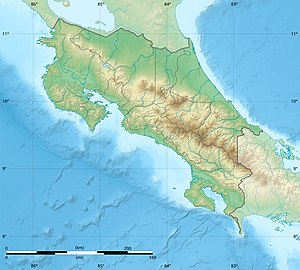El Diquís hydropower project
| Proyecto Hidroeléctrico El Diquís | |||||||
|---|---|---|---|---|---|---|---|
|
|||||||
|
|
|||||||
| Coordinates | 9 ° 4 '56 " N , 83 ° 17' 44" W | ||||||
| Data on the structure | |||||||
| Lock type: | CFRD dam | ||||||
| Construction time: | 2018 [obsolete] –2025 (planned) | ||||||
| Height of the barrier structure : | 170 m | ||||||
| Height of the structure crown: | 310 m | ||||||
| Building volume: | 12.2 million m³ | ||||||
| Crown length: | 700 m | ||||||
| Power plant output: | 631 to 652 MW | ||||||
| Operator: | Grupo ICE (Instituto Costarricense de Electricidad) | ||||||
| Data on the reservoir | |||||||
| Water surface | 68.15 km² | ||||||
The El Diquís hydropower project is a dam project of the ICE ( Instituto Costarricense de Electricidad ), the electricity supply of Costa Rica , which is currently being planned. It is located between Buenos Aires , Osa, and Pérez Zeledón. With 631 MW, it will be the most powerful hydropower plant in Central America when completed . It will generate electricity for more than a million consumers; it outperforms the Pirrís hydropower plant , which was completed in January 2011 and should start production in September 2011. 7363.5 hectares of land will be used for the project, 915.6 hectares of which will be indigenous territory. 3,500 jobs will be created in the region and the electricity produced could be exported to neighboring countries. When construction [obsolete] begins in 2018 , it could be completed in 2025 .
The dam's hydropower plant is said to be some distance away at Palmar Norte . This includes two transfer tunnels .
Previous planning Boruca
The major project, which cost 2 billion US dollars, is the successor to the Boruca dam project , which has been in planning for more than 30 years. It is now called “Proyecto Hidroeléctrico Diquis”. Diquis means "great river" in the language of the Terraba. So far, the project has been named after the Boruca people and was located in a slightly different location. This included an aluminum plant. Protests by the Boruca people prevented the building. The client ICE then relocated the project to the land of Térraba directly to the west. Now the Río General is to be dammed instead of the Río Térraba . The Térraba arises from the confluence of the Río General and Río Coto Brus .
Indigenous protest
The construction plans are opposed by the indigenous people of the Terraba , among other things because approx. 1500 people would have to be resettled.
To the context
Costa Rica has been producing 100% of its electricity from renewable energies since the beginning of 2015.
Around 2006 Costa Rica had geothermal power plants with an output of 145 megawatts (MW) and wind turbines with 62 MW. The geothermal output was increased by almost 50% by 2012 and that of the wind turbines to 148 MW. Between 2015 and 2025, 210 MW of geothermal power and 215 MW of wind power are to be added. In 2021 the country should produce its electricity completely CO 2 -neutral. Overcapacity may be created. The prices for wind turbines have fallen.
See also
Web links
- Proyecto Hidroeléctrico El Diquís Official Website
- El Heraldo - Honduras Construirán hidroeléctrica más grande de CA.
- El Nuevo Diario - Nicaragua Costa Rica contará con la planta hidroeléctrica más grande de Centroamérica
- INBio Instituto Nacional de Biodiversidad realiza el primer estudio de insectos para un Proyecto Hidroeléctrico
- Proyecto Hidroeléctrico El Diquís website of Grupo ICE
Individual evidence
- ↑ http://www.crhoy.com/archivo/proyecto-hidroelectrico-diquis-se-transforma-en-proyecto-estrella-para-el-gobierno/nacionales/
- ↑ Ralf Streck: 100% green electricity in Costa Rica. March 25, 2015, accessed April 2, 2018 .
